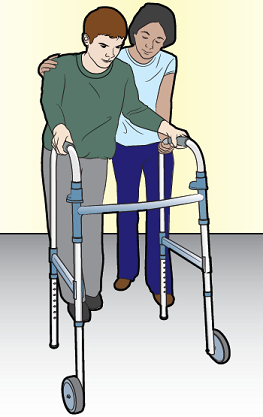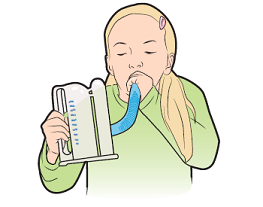This information explains how your child can stay active before and after surgery. It also explains how Memorial Sloan Kettering’s (MSK’s) Rehabilitation Services can help your child.
About MSK’s Rehabilitation Services
Activity and movement are important to help your child grow and develop. Being in the hospital and staying in one room can reduce your child’s mobility (ability to move) and level of activity. This can decrease your child’s strength and play skills and delay their development.
MSK’s rehabilitation (rehab) services can help your child get their strength back after surgery. Rehab services can also help improve their ability to do everyday activities. Occupational therapists (OT), physical therapists (PT), or both may work with your child after surgery, depending on their needs. They’ll make sure your child stays active and engaged while they’re in the hospital. Having your child take part in therapy is an important part of their recovery. It’s also important that you help them during and after therapy sessions.
Occupational therapists
OTs work to improve your child’s ability to do important everyday activities after surgery. An OT may help your child with any problems they have with self-care tasks, such as dressing or grooming, play activities, and school or work-based skills (see Figure 1).

Figure 1. Working with an OT
During an occupational therapy session, the OT will:
- Talk with your child about their everyday activities. They’ll ask how they were doing those activities before surgery.
- Check the strength, sensation (feeling), and movement in your child’s fingers and arms.
- Ask questions to see if your child can understand directions, solve problems, pay attention, and remember things.
-
See how your child does everyday activities, including:
- Getting in and out of bed
- Putting on and taking off clothes
- Walking to and from the bathroom, and using the bathroom
- Brushing their teeth
- Playing with toys
Physical therapists
PTs work to improve your child’s ability to move and function after surgery. A PT may help your child get back their strength, balance, and coordination. This will help them with activities such as walking, climbing the stairs, and playing sports (see Figure 2).

Figure 2. Working with a PT
During a physical therapy session, the PT will:
- Talk with your child about their home and school settings. They’ll ask about any problems they may have with moving their body.
- Measure the strength, balance, movement, and sensation in your child’s arms and legs.
- Check your child’s breathing and their ability to cough.
-
See how much help your child needs with everyday activities, including:
- Getting in and out of bed
- Standing up from a chair
- Walking up and down stairs
Helping Your Child Prepare for Surgery
- It’s important for your child to stay active before their surgery. They can do this by going for walks, exercising, and doing their everyday activities as usual.
- Make sure your child follows their daily routines. This includes self-care tasks such as bathing, brushing their teeth, and combing their hair.
- Pack whatever your child needs to keep their routines during their hospital stay. This includes pajamas, clothes, shoes, and a toothbrush from home. You can also bring their favorite toys or games to help comfort them during their hospital stay.
- Bring any special equipment or items your child needs to help them move around during their hospital stay. This includes crutches, a walker, a wheelchair, or arm or leg braces. This will help them move safely after surgery.
- Look at a calendar with your child to show them the day of their surgery. Bring the calendar to the hospital and use it to keep track of the days after their surgery.
- Tell your child they may meet with an OT, a PT, or both after surgery. Talk with them about what to expect. Let them know they’ll be helped out of bed to play, sit in a chair, or walk around.
What to Expect After Surgery
After surgery, your child will have intravenous (IV) lines and medical tubes connected to them. This will help give them medications and drain fluids. Your child’s OT, PT, or both will manage their IV lines and tubes so they can move safely and take part in therapy.
If your child needs continued oxygen therapy to help with breathing, a respiratory therapist and nurse will work with their OT, PT, or both. They’ll all make sure your child gets the support they need during therapy.
Helping Your Child Recover From Surgery
Take part in physical and occupational therapy sessions
Depending on your child’s needs after surgery, they may take part in physical therapy sessions, occupational therapy sessions, or both.
The PT, OT, or both will work with your child to help them:
- Get their strength back
- Move around on their own
- Reduce their pain
- Improve their breathing
- Cough and clear secretions (mucus) from their lungs
- Increase their alertness and ability to follow directions
- Do their everyday activities
- Increase their play skills
- Get ready for their return home
Engage your child
Anesthesia (medication to make you sleep during surgery), medications, and an unfamiliar setting can make your child feel confused. It can also be hard for them to keep track of the time or where they are. Talk with your child about being in the hospital. Let them know what the date and time of day are. Let them know what the nurses, doctors, and therapists are in the room to do.
Keep the window shades up and the lights on in the hospital room during the daytime. Turn the lights off at night to help your child keep a routine sleep schedule.
Encourage your child to play games and do activities they enjoy, such as playing card games, reading, coloring, and doing puzzles. A good place to do these activities is out of bed while sitting in a chair whenever possible.
Walk around
It’s important for your child to walk around after surgery. If your child is old enough to walk, having them walk every 2 hours is a good goal. This will help prevent blood clots in their legs, improve their strength, and reduce the length of their hospital stay. Your child’s nurses, therapists, or both will help them with sitting up and getting out of bed within 24 hours after surgery.
Do deep breathing exercises

Figure 3. Using an incentive spirometer
Taking deep breaths can sometimes be painful after surgery because of incisions (surgical cuts) in your child’s chest or abdomen (belly). To help improve your child’s breathing, their nurse, therapist, or both will practice deep breathing exercises with them. They’ll do this by blowing bubbles and using an incentive spirometer (see Figure 3). Using an incentive spirometer helps expand your child’s lungs and keeps them from getting pneumonia (lung infection).
For more information, ask your child’s nurse for the resource How To Use Your Incentive Spirometer.
Contact Information
If you have any questions about helping your child stay active before or after surgery, call MSK’s Rehabilitation Services at 212-639-7833. You can reach them Monday through Friday, between and